 W
WBahadur Shah Zafar or Bahadur Shah II was the twentieth and last Mughal Emperor of India. He was the second son of and became the successor to his father, Akbar II, upon his death on 28 September 1837. He was a titular Emperor, as the Mughal Empire existed in name only and his authority was limited only to the walled city of Old Delhi (Shahjahanbad). Following his involvement in the Indian Rebellion of 1857, the British exiled him to Rangoon in British-controlled Burma, after convicting him on several charges.
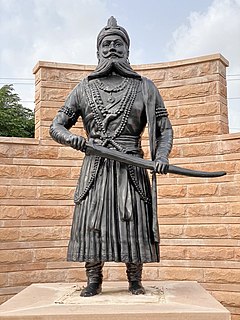 W
WKushal Singh Champawat also known as Khushal Singh Champawat was the Thakur of a prominent Thikana of Auwa in Jodhpur State. During Indian rebellion of 1857, he defeated the British Army led by Agent to Governor General of Rajputana, General Lawrence in the Battle of Chelawas.
 W
WDhan Singh Gurjar, also known as Dhunna Singh, was the Indian kotwal of Meerut, who participated in the 1857 rebellion and led initial actions against the British East India Company in Meerut.
 W
WGanga Baba, or Gangu Baba was a participant in Indian Rebellion of 1857.He belonged to Valmiki community living around Bithoor village of Uttar Pradesh.
 W
WJhalkaribai was a woman soldier who played an important role in the Indian Rebellion of 1857. She served in the women's army of Rani Lakshmibai of Jhansi. She eventually rose to a position of a prominent advisor to the queen, Rani of Jhansi. At the height of the Siege of Jhansi, she disguised herself as the queen and fought on her behalf, on the front, allowing the queen to escape safely out of the fort.
 W
WKarunkar Singh Naik, commonly known as Karunakar Singh, was an Indian chieftain and rebel leader. He was the Gond Gauntia of Kolabira in what is today the Jharsuguda district of Odisha.
 W
WAzimullah Khan Yusufzai, also known as Dewan Azimullah Khan, was initially appointed Secretary, and later Prime Minister to Shrimant Nana Saheb Peshwa II. He is also known as the Krantidoot Azimullah Khan.
 W
WGeneral Bakht Khan was commander-in-chief of the Indian independent forces in the region of Delhi during the Indian Rebellion of 1857 against the East India Company.
 W
WChandan Hajuri popularly known as 'Chakhi Khuntia' was a Jagannath Temple priest and a poet who participated in the Indian Rebellion of 1857.
 W
WMadhab Singh Bariha or Madho Singh was the Binjhal Zamindar (landlord) of Ghess locality of Bargarh district in Odisha and was a close associate of Veer Surendra Sa in the Sambalpur uprising against the British East India Company. He was hanged to death at the age of 72 on 31 December 1858 at Jail Chowk of Sambalpur, after being caught in the same year for his ferocious and heroic resistance to the British takeover of the region with their appalling policies. Three out of his four valiant sons were martyred while the eldest was sentenced to life imprisonment. His granddaughter Purnima committed suicide after the British hanged her rebellious husband from the Sonakhan Zamindari at Raipur.
 W
WBegum Hazrat Mahal, also known as the Begum of Awadh, was the second wife of Nawab of Awadh Wajid Ali Shah, and the regent of Awadh in 1857–1858. She is known for the leading role she had in the rebellion against the British East India Company during the Indian Rebellion of 1857.
 W
WSultan Muhammad Zahir ud-din, better known as well Mirza Mughal, was a Mughal prince. He played a significant role during the Indian Rebellion of 1857. He was one of the Mughal princes shot dead at one of the gates of Old Delhi, which gate thereafter came to be known as "Khooni Darwaza".
 W
WMangal Pandey was an Indian soldier who played a key part in the events immediately preceding the outbreak of the Indian rebellion of 1857. He was a sepoy (infantryman) in the 34th Bengal Native Infantry (BNI) regiment of the British East India Company. In 1984, the Indian government issued a postage stamp to remember him. His life and actions have also been portrayed in several cinematic productions.
 W
WBirjis Qadr was the Nawab of Awadh from 1857 until 1858.
 W
WRaghojirao Ramjirao Bhangre also spell Bhangaria was an Indian revolutionary who challenged and defied the British power in Maharashtra. He was the son of Ramji Bhangre, a Koli who also resisted the British rule and was subsequently hanged in Cellular Jail. he was only ten years old when he took up arms against British rule in Maharashtra.
 W
WRao Tularam Singh was an Yaduvanshi Ahir King or chieftain of Rewari. He was one of the key leaders of the Indian rebellion of 1857 in Haryana, where he is considered a state hero.
 W
WLakshmibai, the Rani of Jhansi, was the Maharani consort of the Maratha princely state of Jhansi from 1843 to 1853 as the wife of Maharaja Gangadhar Rao. She was one of the leading figures of the Indian Rebellion of 1857 and became a symbol of resistance to the British Raj for Indian nationalists. She died in the Rebellion, from wounds received in a battle on 18 June 1858. The Rebellion was suppressed by November that year.
 W
WKhan Bahadur Khan Rohilla was the grandson of Hafiz Rahmat Khan, who was the Nawab of Rohilkhand in Uttar Pradesh. He formed his own government in Bareilly in the 1857 Indian revolt against the British. When the Indian Rebellion of 1857 failed, Bareilly, too, was subjugated by the British. He escaped to Nepal where the Nepalese captured him and turned him over to the British. Khan Bahadur Khan Rohilla was sentenced to death and hanged in the Kotwali on 24 February 1860.
 W
WNana Saheb Peshwa II, born as Dhondu Pant, was an Indian Peshwa of the Maratha empire, aristocrat and fighter, who led the rebellion in Kanpur (Cawnpore) during the Great Revolt of 1857. As the adopted son of the exiled Marathi Brahmin King Peshwa Baji Rao II, Nana Saheb believed that he was entitled to a pension from the East India Company, but the underlying contractual issues are rather murky. The Company's refusal to continue the pension after his father's death, as well as what he perceived as high-handed policies, led him to join the rebellion. He forced the British garrison in Kanpur to surrender, then murdered the survivors, gaining control of Kanpur for a few days. He later disappeared, after his forces were defeated by a British force that recaptured Kanpur. He went to the Nepal Hills in 1859, where he is thought to have died.
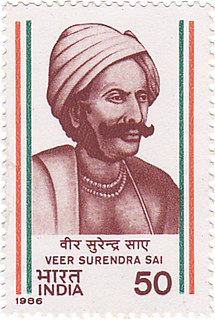 W
WSurendra Sai was an Indian freedom fighter who sacrificed his life fighting against the British East India Company. Surendra Sai and his associates Madho Singh, Kunjal Singh, Airi Singh, Bairi Singh, Uddant Sai, Ujjal Sai, Khageswar Dao, Karunakar Singh, Salegram Bariha, Govind Singh, Pahar Singh, Rajee Ghasia, Kamal Singh, Hati Singh, Salik Ram Bariha, Loknath Panda/Gadtia, Mrutunjaya Panigrahi, Jagabandu Hota, Padmanave Guru, Trilochan Panigrahi and many others resisted the British and successfully protected most parts of Western Odisha region for some time from the British rule. Most of them died unnoticed fighting for freedom from the British. Many of them were hanged by the British; Hatte Singh died in the Vapor Island in the Andamans. Surendra Sai died in Asirgarh Jail on 28 February 1884.
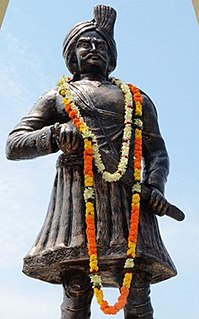 W
WVishwanath Shahdeo was the king of Barkagarh estate and a rebel in the Indian rebellion of 1857. He and his followers attacked a force of the British East India Company in Ranchi and caused the British to flee. He was eventually caught, found guilty of treason and was hung from a tree along with his accomplices.
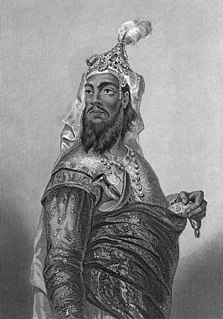 W
WKunwar Singh was a leader during the Indian Rebellion of 1857. He belonged to a family of the Ujjainiya clan of the Parmar Rajputs of Jagdispur, currently a part of Bhojpur district, Bihar, India. At the age of 80, he led a selected band of armed soldiers against the troops under the command of the British East India Company. He was the chief organiser of the fight against the British in Bihar. He is popularly known as Veer Kunwar Singh or Veer Babu Kunwar Singh.
 W
WRajkumar Lal Pratap Singh was a member of the Bisen Rajput dynasty of Kalakankar. He was prominent leader in the Indian Rebellion of 1857. He was killed during the 1858 Battle of Chanda. The Government of India issued a postage stamp on 17 December 2009 to commemorate him.
 W
WRaja Nahar Singh was a great Jat ruler of the princely state of Ballabhgarh in Faridabad District of Haryana, India. They built a fort in Faridabad around 1739. He was involved in the Indian Rebellion of 1857. The small kingdom of Ballabhgarh is only 20 miles from Delhi. His palace is taken over by the government of Haryana under Haryana Tourism. Nahar Singh Stadium in Faridabad is named after him. The Raja Nahar Singh metro station in Violet line is also named after the martyr.
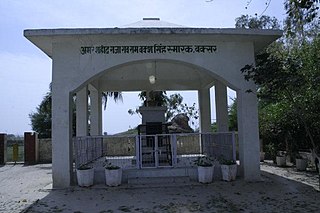 W
WRaja Rao Ram Baksh Singh was a Bais Rajput who was the Raja Rao of Daundia Khera of Unnao district of Uttar Pradesh in the then Oudh province that was a vassal state of the British East India Company. He was one of the leaders of the Sepoy Mutiny, and a close associate of Nana Sahib. He was hanged by the British on 28 December 1857 for taking part in the revolt and being found guilty of the killing of British soldiers. In 1992, the Government of India built a memorial at the place where he was hanged to honor his death.
 W
WVeer Narayan Singh (1795–1857) was a landlord from Sonakhan, Chhattisgarh. He spearheaded the 1857 war of Indian independence in Chhattisgarh. He was hanged at Jaistambh Chowk of Raipur, Chhattisgarh.
 W
WTantia Tope also spelled as Tatya Tope, was a general in the Indian Rebellion of 1857 and one of its notable leaders. Despite lacking formal military training, Tantia Tope is widely considered as the best and most effective rebel general.
 W
WUda Devi was a warrior in the Indian Rebellion of 1857, who fought against the British East India Company.